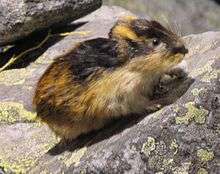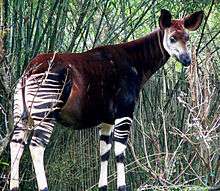Lemming
A lemming is a small rodent, usually found in or near the Arctic in tundra biomes. Lemmings make up the subfamily Arvicolinae (also known as Microtinae) together with voles and muskrats, which form part of the superfamily Muroidea, which also includes rats, mice, hamsters, and gerbils. In popular culture, a longstanding myth holds that they commit mass suicide.
| Lemming | |
|---|---|
 | |
| Lemmus lemmus | |
| Scientific classification | |
| Kingdom: | |
| Phylum: | |
| Class: | |
| Order: | |
| Family: | |
| Subfamily: | |
| Tribe: | Lemmini |
| Genera | |
Description and habitat
Lemmings measure around 13–18 cm (5–7 in) in length and weigh around 23–34 g (0.8–1.2 oz). Lemmings are quite rounded in shape, with brown and black, long, soft fur. They have a very short tail, a stubby, hairy snout, short legs, and small ears. They have a flattened claw on the first digit of their front feet, which helps them to dig in the snow. They are herbivorous, feeding mostly on mosses and grasses. They also forage through the snow surface to find berries, leaves, shoots, roots, bulbs, and lichens.[1]
Lemmings choose their preferred dietary vegetation disproportionately to its occurrence in their habitat.[2] They digest grasses and sedges less effectively than related voles.[3]
Like other rodents, their incisors grow continuously, allowing them to feed on much tougher forage.
Lemmings do not hibernate through the harsh northern winter. They remain active, finding food by burrowing through the snow. These rodents live in large tunnel systems beneath the snow in winter, which protect them from predators. Their burrows have rest areas, toilet areas, and nesting rooms. They make nests out of grasses, feathers, and muskox wool (qiviut). In the spring, they move to higher ground, where they live on mountain heaths or in forests, continuously breeding before returning in autumn to the tundra.
Behavior
Like many other rodents, lemmings have periodic population booms and then disperse in all directions, seeking the food and shelter their natural habitats cannot provide. The Norway lemming and brown lemming are two of the few vertebrates which reproduce so quickly that their population fluctuations are chaotic,[4][5] rather than following linear growth to a carrying capacity or regular oscillations. Why lemming populations fluctuate with such great variance roughly every four years, before numbers drop to near extinction, is not known.[6] Lemming behaviour and appearance are markedly different from those of other rodents, which are inconspicuously coloured and try to conceal themselves from their predators. Lemmings, by contrast, are conspicuously coloured and behave aggressively toward predators and even human observers. The lemming defence system is thought to be based on aposematism (warning display).[7] Fluctuations in the lemming population affect the behaviour of predators, and may fuel irruptions of birds of prey such as snowy owls to areas further south.[8]
For many years, the population of lemmings was believed to change with the population cycle, but now some evidence suggests their predators' populations, particularly those of the stoat, may be more closely involved in changing the lemming population.
Misconceptions
Misconceptions about lemmings go back many centuries. In the 1530s, geographer Zeigler of Strasbourg proposed the theory that the creatures fell out of the sky during stormy weather[9] and then died suddenly when the grass grew in spring.[10] This description was contradicted by natural historian Ole Worm, who accepted that lemmings could fall out of the sky, but claimed that they had been brought over by the wind rather than created by spontaneous generation. Worm first published dissections of a lemming, which showed that they are anatomically similar to most other rodents such as voles and hamsters, and the work of Carl Linnaeus proved that they had a natural origin.
Lemmings have become the subject of a widely popular misconception that they are driven to commit mass suicide when they migrate by jumping off cliffs. It is not a deliberate mass suicide where the animal voluntarily chooses to die, but rather a result of their migratory behavior. Driven by strong biological urges, some species of lemmings may migrate in large groups when population density becomes too great. They can swim and may choose to cross a body of water in search of a new habitat. In such cases, many drown if the chosen body of water happens to be an ocean, or is in any case so wide as to exceed their physical capabilities. Thus, the unexplained fluctuations in the population of Norwegian lemmings, and perhaps a small amount of semantic confusion (suicide not being limited to voluntary deliberation, but also the result of foolishness), helped give rise to the popular stereotype of the suicidal lemmings, particularly after this behavior was staged in the Walt Disney documentary White Wilderness in 1958.[11] The misconception itself is much older, dating back to at least the late 19th century, where in the August 1877 issue of Popular Science Monthly, apparently suicidal lemmings are presumed to be swimming the Atlantic Ocean in search of the submerged continent of Lemuria.[12]
Another myth may have roots in the fiercely aggressive nature of lemmings during population booms, and the corresponding leftovers of predatory frenzies: lemmings do not explode.[11]
In popular culture and media
The misconception of lemming "mass suicide" is long-standing and has been popularized by a number of factors. It was well enough known to be mentioned in "The Marching Morons", a 1951 short story by Cyril M. Kornbluth. In 1955, Disney Studio illustrator Carl Barks drew an Uncle Scrooge adventure comic with the title "The Lemming with the Locket". This comic, which was inspired by a 1953 American Mercury article, showed massive numbers of lemmings jumping over Norwegian cliffs.[13][14] Perhaps the most influential and, for the lemmings involved, tragic, presentation of the myth was the 1958 Disney film White Wilderness which won an Academy Award for Documentary Feature and in which producers threw lemmings off a cliff to their deaths to fake footage of a "mass suicide", as well as faked scenes of mass migration.[15] A Canadian Broadcasting Corporation documentary, Cruel Camera, found the lemmings used for White Wilderness were flown from Hudson Bay to Calgary, Alberta, Canada, where far from "casting themselves bodily out into space" (as the film's narrator states), they were, in fact, dumped off the cliff by the camera crew from a truck.[16][17] Because of the limited number of lemmings at their disposal, which in any case were the wrong sub-species, the migration scenes were simulated using tight camera angles and a large, snow-covered turntable.
Lemmings also appear in Arthur C. Clarke's 1953 short story "The Possessed", where their suicidal urges are attributed to the lingering consciousness of an alien group mind, which had inhabited the species in the prehistoric past.[18]
The song "Lemmings (Including 'Cog')" from the 1971 album Pawn Hearts by progressive rock band Van der Graaf Generator is about a person who sees their loved ones "crashing on quite blindly to the sea".[19]
In 1991, a puzzle-platform video game called Lemmings was released.
Classification
- Order Rodentia
- Superfamily Muroidea
- Family Cricetidae
- Subfamily Arvicolinae: voles, lemmings, and related species
- Tribe Dicrostonychini
- Dicrostonyx
- Northern collared lemming (D. groenlandicus)
- Ungava collared lemming (D. hudsonius)
- Victoria collared lemming (D. kilangmiutak)
- Nelson's collared lemming (D. nelsoni) or St. Lawrence Island collared lemming (D. exsul)
- Ogilvie Mountains collared lemming (D. nunatakensis)
- Richardson's collared lemming (D. richardsoni)
- Bering collared lemming (D. rubricatus)
- Arctic lemming (D. torquatus)
- Unalaska collared lemming (D. unalascensis)
- Wrangel lemming (D. vinogradovi)
- Dicrostonyx
- Tribe Lemmini
- Lemmus
- Amur lemming (L. amurensis)
- Norway lemming (L. lemmus)
- Siberian brown lemming (L. sibiricus)
- North American brown lemming (L. trimucronatus)
- Wrangel Island lemming (L. portenkoi)
- Myopus
- Wood lemming (M. schisticolor)
- Synaptomys
- Northern bog lemming (S. borealis)
- Southern bog lemming (S. cooperi)
- Lemmus
- Tribe Arvicolini: over 120 species
- Eolagurus
- Yellow steppe lemming (E. luteus)
- Przewalski's steppe lemming (E. przewalskii)
- Lagurus
- Steppe lemming (L. lagurus)
- Over 100 other species not known as lemmings
- Eolagurus
- Tribe Dicrostonychini
- Subfamily Arvicolinae: voles, lemmings, and related species
- Family Cricetidae
- Superfamily Muroidea
See also

References
- Soininen, Eeva; Zinger, Lucie; Gielly, Ludovic; Yoccoz, Nigel; Henden, John-André; Ims, Rolf (4 April 2017). "Not only mosses: lemming winter diets as described by DNA metabarcoding". Polar Biology. 40 (10): 2097–2103. doi:10.1007/s00300-017-2114-3. hdl:10037/12365.
- Batzli, George O; Pitelka, Frank A (1983). "Nutritional Ecology of Microtine Rodents: Food Habits of Lemmings near Barrow, Alaska". Journal of Mammalogy. 64 (4): 648–655. doi:10.2307/1380521. JSTOR 1380521.
- Batzli, George O; Cole, F Russell (1979). "Nutritional Ecology of Microtine Rodents: Digestibility of Forage". Journal of Mammalogy. 60 (4): 740–750. doi:10.2307/1380189. JSTOR 1380189.
- Turchin, Peter (2003). Complex Population Dynamics: A Theoretical/Empirical Synthesis. Princeton University Press. p. 391. ISBN 978-0-691-09021-4.
- Stenseth, N. C.; Chan, K. S.; Framstad, E.; Tong, H. (1998). "Phase- and density-dependent population dynamics in Norwegian lemmings: Interaction between deterministic and stochastic processes". Proceedings. Biological Sciences. 265 (1409): 1957–68. doi:10.1098/rspb.1998.0526. JSTOR 51151. PMC 1689487. PMID 9821362.
- Hinterland Who's Who – Lemmings Archived 2011-11-07 at the Wayback Machine
- Andersson, Malte (1976). "Lemmus lemmus: A Possible Case of Aposematic Coloration and Behavior". Journal of Mammalogy. 57 (3): 461–469. doi:10.2307/1379296. JSTOR 1379296.
- Fears, Darryl (24 February 2014). "Lemmings fuel biggest snowy-owl migration in 50 years". The Guardian. Retrieved 9 March 2018.
- This notion is also featured in the folklore of the Inupiat and Yupik peoples at Norton Sound.
- "Lemmings Suicide Myth". ABC Science. Karl S. Kruszelnicki Pty Ltd. 27 April 2004. Archived from the original on 14 July 2007.
- Nicholls, Henry (21 November 2014). "The truth about Norwegian lemmings". BBC Earth. Archived from the original on 24 November 2014. Retrieved 9 June 2019.
- Crotch, William Duppa (August 1877). . Popular Science Monthly. D. Appleton & Company. Vol. 11. pp. – via Wikisource.
- Lederer, Muriel. "Return of the Pied Piper". The American Mercury, Dec. 1953, pp. 33–34 Archived 2014-01-03 at the Wayback Machine.
- Blum, Geoffrey. (1996). "One Billion of Something", in: Uncle Scrooge Adventures by Carl Barks, #9.
- "'White Wilderness' Faked Lemming Suicides". Snopes.com. 12 December 2015.
- Cruel Camera Archived 2009-01-17 at the Wayback Machine Time slice: 14:01–15:27
- Moss, Tyler (10 June 2013). "Do Lemmings Really Run Off Cliffs to Their Death?". Mental Floss. Archived from the original on 7 April 2014.
- Clarke, Arthur C. (2001). The Collected Stories of Arthur C. Clarke. Tor Books. pp. 423–427. ISBN 978-0-575-07065-3.
- Van der Graaf Generator – Lemmings, retrieved 2020-06-14
External links
| Look up lemming in Wiktionary, the free dictionary. |
| Wikimedia Commons has media related to: |
- "The Lemming Cycle" (PDF). Archived from the original (PDF) on 2005-12-23(92.6 KiB). Article by Nils Christian Stenseth on the population cycles of lemmings and other northern rodents.
- See also "The Lemming Cycle", in HTML format.
- "Collared Lemming" (PDF)(177 KiB). Article about Collared Lemming, see also the main page on Alaskan mammals.
- Rebuttal of lemming suicide: